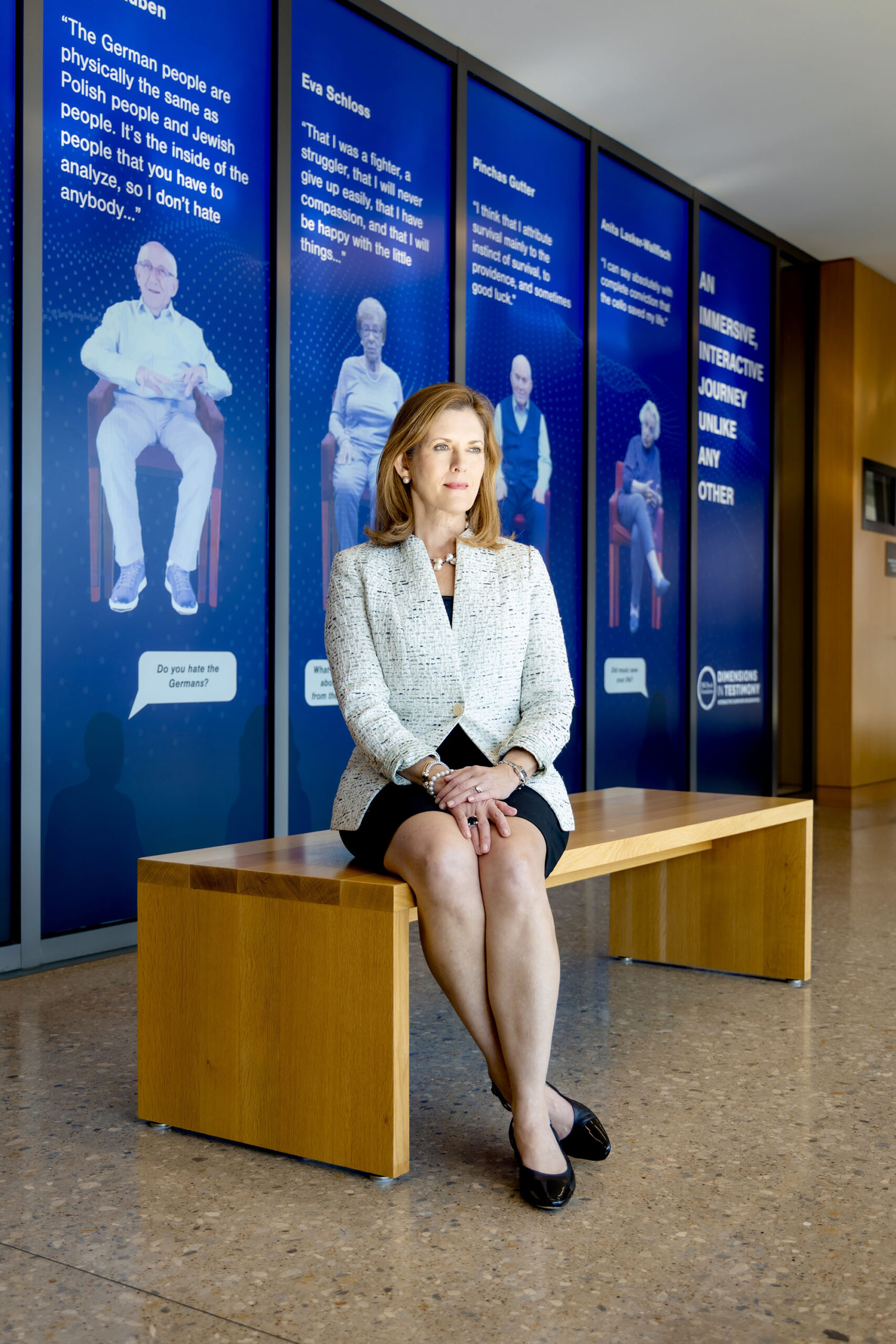Story bY Claire Collins. Photos by Jerry Crayton.

Today, what started as a small but impactful exhibit, housed on the first floor of the Dallas Jewish Community Center (JCC), has grown to a 55,000-square-foot facility with a multi-pronged permanent collection featuring the Holocaust/Shoah Wing, Human Rights Wing, and Pivot to America Wing.
The museum also houses a Cinemark theater that shows survivor testimonies and mission-focused films hourly, as well as the Dimensions in Testimony Theater, a truly unique and unparalleled experience in which viewers engage with and ask questions of holograms of actual survivors.
“If you have visited our old site and think you’ve seen it all, you need to come back—our new space is totally different,” Museum President and CEO, Mary Pat Higgins said. “You could spend at least three hours in the Holocaust wing alone.”
From 1984 to 2005, the original museum was housed in the JCC. It focused on one singular, seminal day in the Holocaust. In 2005, the museum grew and moved to a space in the West End, broadening the permanent collection to a 6,000-square-foot exhibit. In 2018, over 80,000 visitors came to the museum- a record-breaking year, and a meaningful way to herald the 2019 opening of the beautiful 55,000-square-foot facility the museum calls home today.

And then COVID hit.
“The reality is, we opened this fabulous, world-class museum in 2019, that features three comprehensive wings in the permanent exhibit, a beautiful Cinemark theater, and world-renowned special exhibitions, and shortly after opening, the pandemic hit, and we closed for five months,” Mary Pat says. “When we re-opened, the world was not going back to museums.”
And the world was changed. The Anti-Defamation League (ADL), which tracks hate nationwide, reports antisemitic events have increased by 75 percent since the start of the pandemic. Antisemitism holds the dubious title of “oldest” hatred in the world. It is not new, it is very nuanced, and it is pervasive in society. In many ways, it is the canary in the coal mine for how divided our world is becoming. When antisemitism spikes, you can trust all forms of religious hate, prejudice against sexual orientation, and racism are on the rise, and today, we know for certain they are.
The marked increase in tracked hatred, coupled with declining general admissions to places like the Dallas Holocaust and Human Rights Museum, signals that educating the general population about the dangers of hate and prejudice is more important than ever. A 2018 survey conducted by the Conference on Jewish Material Claims Against Germany found only 36 percent of American millennials know about the Holocaust.
“There is a new sense of urgency,” Mary Pat says. “We are more polarized as a country than we’ve ever been—certainly in our lifetime. As such, it is more important than ever to look at the dangers of polarization and recognize the 10 stages of genocide.” History shows that genocides and other human horrors begin with unchecked prejudice and bystanders who remain silent.
One of the central tenants taught at the museum is how to be an “upstander,” someone who speaks out against hate or discrimination. This is woven through the entire museum’s messaging and presented in the curriculum the museum shares with local schools and child-serving organizations.
“Most of us don’t have to risk our own lives to stand up for what is right, but we hope to help people understand the choices we make really do make a difference,” Mary Pat says. “It’s much easier to be a bystander; we hope to challenge everyone to find ways to become an upstander even when it’s hard.”
The museum is recommended for ages 12 and up, due to the seriousness of the topics featured and transparency in presentation.
“The good news is while general admissions are down, schools are coming back. Typically, school-aged children constitute half of our total admission, so we are thrilled those partnerships are still strong,” Mary Pat says.
If you visit the museum today, you will find the permanent exhibit, which features the Holocaust/Shoah Wing, which covers life in Europe from 1933-1945; the Human Rights Wing, which includes the Ten Stages of Genocide Gallery, illustrating through graphic novels, how human cruelty can escalate and destroys lives in all corners of the world; and the Pivot to America Wing, which explores the ideals of our nation, how we live up to them, where we fall short, and how we can move forward together.
Spend time in the Dimensions in Testimony theater and interact with holograms of real survivors in a specially designed space that allows detailed conversation between guests and survivors. Every Friday, Max Glauben, a 91-year-old Dallasite and Holocaust survivor, is featured. The Dallas Holocaust and Human Rights Museum is one of only two museums in the country offering this cutting-edge presentation. The other is the Holocaust Museum in Skokie, Illinois.
The current special exhibitions Rise Up: Stonewall and the LGBTQ Rights Movement conclude at the end of June, which is PRIDE month. Beginning July 21, Black Citizenship in the Age of Jim Crow will open and run through Dec. 31, 2023. The exhibition starts with Reconstruction and takes the viewer through the following 50 years of discrimination under Jim Crow.
According to Mary Pat, the study of history has become polarizing in today’s climate, but as the museum highlights, ignoring history has dire consequences.
“Looking to the past and understanding what happens when rights are lost is critical in preserving our society,” Mary Pat says. “There is hope in understanding history.”
You can visit the website if you would like to learn more about the Dallas Holocaust and Human Rights Museum, donate, or purchase tickets.
Sign up with your email address to receive good stories, events, and volunteer opportunities in your inbox.
Notifications